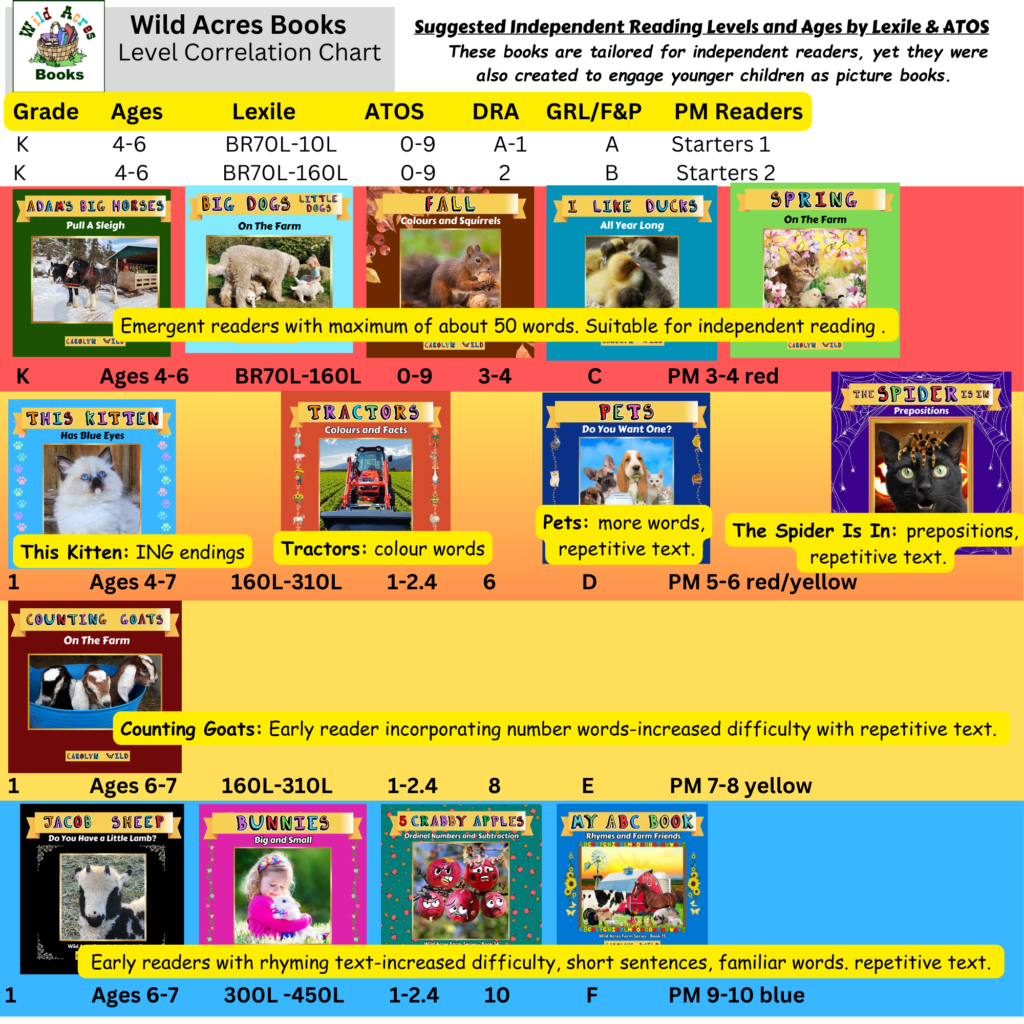To gain a comprehensive understanding of the book leveling process and to determine your child’s reading level, I recommend visiting this webpage:
https://carolynwild.ca/what-are-leveled-books/

To assess your child’s reading level commonly used methods include the Five-Finger Method and Running Records.
Five-Finger Method
- Have the child read a page of a book.
- Raise a finger for each word they struggle with.
- If several fingers are raised, the material may be too challenging.

Running Records
- Assess oral reading skills by observing pronunciation, noting skips, and checking comprehension.
- Ask the child to summarize what they’ve read.
- Running records offer insights into fluency, accuracy, and comprehension, pinpointing areas for improvement.
Reading a-z has information and examples of running records – see below:
https://www.readingaz.com/newfiles/levels/runrecord/runrec.html


Guided Reading Levels (GRL)
GRL is also known as F&P or Fountas & Pinnell. This refers to the two educators who first developed this leveling system to support their “Guided Reading“ method for emergent readers and “Reading Recovery” method for struggling beginner readers.
GRL looks at a combination of content and text-to-level books and gives them a letter of the alphabet that corresponds to a certain proficiency in reading. It focuses on grades K-8.
- Levels: Alphabetical from A to Z, with A for early readers and Z for advanced ones.
- Correspondence with Grade Levels: Multiple GRL levels may align with each grade, providing precise classifications.
- Criteria: Determined by factors like word repetition, sentence length, total word count, complexity, illustrations, and high-frequency words.
Developmental Reading Assessment (DRA)
- Levels: Numbered 1 to 80, assessing fluency, accuracy, and comprehension.
- Correspondence with Grade Levels: Different DRA levels within each grade.
- Assessment Areas: Focus on reading fluency, accuracy, and comprehension.

About the Lexile Framework
This leveling system looks at the text’s difficulty, like word frequency and sentence length.
- Measures: Student’s Lexile reading measure and book levels.
- Student Measurement: Falls between BR (below 0L) for beginners to above 2000L for advanced readers.
- Correspondence with Grade Levels: Paired with age-appropriate books for advanced readers.
- Assessment: Determined from a standardized test assessing reading comprehension.
The results are shown in three to four-digit numbers and prefixes.
Here are the prefixes:
- BR = Beginner Reader
- AD = Adult-directed (picture books)
- HL = hi-lo
- NP = Non prose
- GN = Graphic Novel
- IG = Illustrated Guide
- NC = nonconforming
https://hub.lexile.com/find-a-book/search
About ATOS for Books/AR (Accelerated Reader)
With ATOS level given is a number and refers to a grade. This leveling system is also referred to as (ATOS) Advantage TASA Open Standard (TASA is a reading management software).
- Levels: Numeric scale corresponding with expected grade levels.
- Correspondence with Grade Levels: For example, a second-grader might have an AR level of 2.4.
- Assessment: Determined through a computerized test after reading, focusing on comprehension.
https://www.arbookfind.com/UserType.aspx?RedirectURL=%2fdefault.aspx
https://www.renaissance.com/resources/atos-analyzer/atos-analyzer-tool/
How These Leveling Systems Relate
- These measures offer diverse tools for understanding a child’s reading abilities.
- Consider factors like comprehension, fluency, and accuracy, though criteria vary.
- Enable classification of reading materials, simplifying matching with a child’s level.
- Collaboration among teachers, parents, and librarians ensures exposure to varied books aligning with interests.
How to Help Your Child Improve Their Reading
- Encourage regular reading, both with books and online programs.
- Choose books aligned with their interests for engagement.
- Support exposure to a variety of reading materials.
- Monitor progress with appropriate level measures and adjust book selections accordingly.
- Collaborate with teachers and librarians for suitable materials and improvement strategies.
https://www.readinga-z.com/learninga-z-levels/level-correlation-chart/

Reading Levels Explained — Just Right Reads



